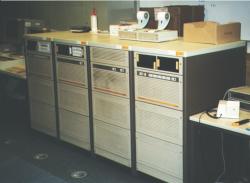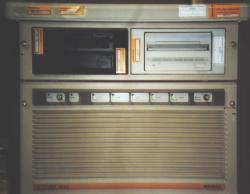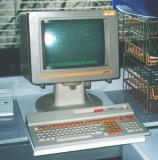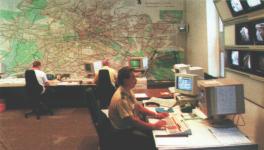Using an internal battery data can be kept for up to 12 hours in RAM during
a power outage (3 hours garanteed).
Also, by using a turnknob, some memory areas can be
locked from access by the processor, these locked out sections can then
be manually addressed as private memory. By using virtual memory access,
it even had some sort of memory protection.
 The picture at the left shows two SICOMP M80 machines which
were in operation as terminal and database servers for a laboratory of the Uni-Klinikum
Erlangen 24 hours a day. The machines needed its own air conditioning system -
nothing unusual back then, the CPUs drew about 2000 Watts at 220 Volts,
the HD boxes about 1700 Watts at 220 Volts (thus producing up to 6660 kJ/h).
The CPU and HD containers each had two powerful fans built in - yes, things were
different a few years ago: consider a FD044 8" floppy drive consumed about 180 Watts...
The picture at the left shows two SICOMP M80 machines which
were in operation as terminal and database servers for a laboratory of the Uni-Klinikum
Erlangen 24 hours a day. The machines needed its own air conditioning system -
nothing unusual back then, the CPUs drew about 2000 Watts at 220 Volts,
the HD boxes about 1700 Watts at 220 Volts (thus producing up to 6660 kJ/h).
The CPU and HD containers each had two powerful fans built in - yes, things were
different a few years ago: consider a FD044 8" floppy drive consumed about 180 Watts...
Measuring about 55x120x80 cm they weren't small either - and surely not lightweight (about 250 kg each). Though being large does not mean being slow or unusable. The M80 was quite superior. It could manage up to 11 SCSI-I/SCSI-II harddrives, 300 MB each. It also contained a 5.25" floppy drive, a tape streamer and some MO-drive which was added later (594 MB).
There were also some interesing hardware components such as a buffered realtime clock (nothing special yet), a timer (alerting the system using interrupts) and a periodical alert used for starting system jobs which needed to be run from time to time.
 A large number of the printers attached to it were DR205 types, really large beasts
with sound proof casing. The DR205 was able to print up to 1760 characters per second
and could also print graphics and barcodes.
A large number of the printers attached to it were DR205 types, really large beasts
with sound proof casing. The DR205 was able to print up to 1760 characters per second
and could also print graphics and barcodes.
The picture at the right shows a large (and unfortunately quite shaky)
shot of the front panel of one of the CPUs.
Attached to those M80s were about 20 Siemens "Sichtstation DS 075 B"
terminals ("Sichtstation" is a really weird and bureaucratic german translation
of "video terminal"). They have quite large green screens (maybe 15") and use
(at least that's how i feel) very comfortable to read fonts. They can display
128 different characters and control characters, at the bottom there were two
lines which make up a status display.
Available screen colors were white, green, orange and paper white. As an option,
also a graphics extension (including mouse and graphics tablet), RGB connectors,
an internal magnet card reader, a barcode reader and a key switch for access control
were available. There was even some DS 075 available which emulated a DEC vt220 :).
The keyboards feels really good (much better then today's
PC-Cherry-Keyboards some people say), though they have a _really_ ugly design.
 The terminals are quite lightweight (13kg - keyboard: 1.8kg!) for their size,
but seem to be incredibly clumsy and take a lot of space due to their shape and size
(about 32cm high, 41cm wide, 35cm in depth). Of course this is not only a
disadvantage: I was told those old Siemens terminals are very quite easy to
service as everything is well accessible and easily taken apart.
It's interesting to notice that they even got some screen blanker: after a
few minutes of inactivity the screen goes black and can be restored
by pressing any key.
The terminals are quite lightweight (13kg - keyboard: 1.8kg!) for their size,
but seem to be incredibly clumsy and take a lot of space due to their shape and size
(about 32cm high, 41cm wide, 35cm in depth). Of course this is not only a
disadvantage: I was told those old Siemens terminals are very quite easy to
service as everything is well accessible and easily taken apart.
It's interesting to notice that they even got some screen blanker: after a
few minutes of inactivity the screen goes black and can be restored
by pressing any key.
It seems they can't be used with any other machines than the SICOMP-M series, as they run a highly proprietary protocol named "DK3964R" ("LAUF"-procedure) using some sort of block mode known from IBM mainframes, too. The serial lines of the terminals (V.24/V.28, X.27 or 20mA/TTY lines at up to 19200 baud) were connected to so-called serial PROMEA-MX-cards which were located in the container of the M80 itself and in some add-on box to which the system bus was extended. Due to intelligent I/O-management the subjective performance of the machine is very high. 50 terminals, 30 line printers and 40 serial ports controlling machines can be attached to an M70 without any trouble, the CPU will not hit its maximum load. Also the M80 seemed hardly bothered by many of the terminals being worked at, the CPU load always remained low. The manual says it can serve up to 80 TTYs.
Some interesting I/O cards
The MX-cards are not the only interesting hardware extensions. Besides the usual serial I/O cards ("PROMEA", which could process 256 byte at once including protocol processing) the system had a 1.5 MBit/s fiber optics interface ("DU02") which used a HDLC-based transmission protocol. This fibre line could be up to 2 km in length.
There also were two 10 MBit ethernet cards. One ("DU03") only was
doing the OSI-1 and OSI-2 layers, the other one ("KS100") was advanced enough
to also handle OSI-3 and OSI-4.
The "DU06" I/O card used HDLC (and SDLC) via V.24/V.28, V.36/V.11 and X.21/X.27
at a speed of up to 72kBit/s and could be connected to DatexP, DatexL or ISDN networks.
Other interesting hardware devices which were not part of the system
I photographed were a MB60 reel tape drive for 1/2" tape (730m/150 MB,
120-470kB/s, 1800 W, 200kg) and a hard disk platter drive PS 048-B
(250 MB MFM/12 platters, 1200 kB/s, 2000 Watts).
Operating Systems
There are two operating system available for the SICOMP-M series: BS-M and AMBOSS-4. While BS-M focuses on real time applications, AMBOSS-4 is somewhat more office-centered, concentrating on the userinterface and applications. AMBOSS is short for "Allgemeines Modulares Benutzer-Orientiertes Software System" (this means: "univseral modular user orientated software system")
The system was running the "AMBOSS 4.0" (BS4) Operating System.
The userinterface and the databse of this lab system was completely written
in FORTRAN, the hardcopy of the source filled numerous binders.
AMBOSS offers multitasking, 10 priorites for programs to be run at,
and some sort of I/O quota. Additionally, it offers a spooling system
that operates using virtual devices.
At max. 4094 processes, which are identified by program names or process
numbers, can be simultaneously. The process priority can be specified at
program start or during execution. Without segmentation the
maximum size of each process is about 130kB.
Files are identified by device and filename.
Within the libraries (some sort of directories which may only
contain files, but no other libraries), files are identified by
specifying device, libary-type (data/text/source/...), library name,
filename and version of the file (similar to VMS).
Files could be protected by means of write-protection, ownership
and some group mechanism.
Regarding processes, the system can give information about
type, size, priority, state and segmentation. Concerning the CPU,
the system gives information about CPU-consuption of the OS (system),
CPU-consumtion of the user processes (user) and idleness of the CPU.
Each system has some sort of system console called "Standartmeldegeraet".
You can restrict certain OS commands to this console by specifying
border program numbers - programs with IDs below the border may only
be run/controlled from the console.
The "shell" is called "Standartbedienprogramm" (short: SBP; it means:
"standart operating program"), though it's no real shell - more like
a mixture of menues and forms/prompts as far as I know.
Logging of errors, system calls and I/O operations (log-level can
be specified) was done to a file or log printer.
The languages available for the system were, among others, assembly,
C, Pearl (no typo!), Fortran and Cobol.
There was some quite interesting editor named "MEDIS-M" for SICOMP-Systems.
Nothin special about it, let alone the fact that there was no need to save
the changes done to the file - you edit the file directly on the diskdrive, byte by byte!
Emulating SICOMP M80...
A company called IKPS even wrote some emulator named PC-SIC/NT which simulates a SICOMP M environment under windows NT. According to their paper on the project the emulator is emulating the hardware itself, i.e. including priority levels and interrupts. The devices formerly attached to the M-system are emulated by seperate NT-processes. An Intel P133 running NT is said to be able to reach the speed achieved by a "real" M80 system.
Who uses/used such a system?
 From a picture which was published in "DER SPIEGEL" (39/99, 27th of
September 1999, page 28ff.) we can decude that M-machines are (or at least were)
also used for controlling the traffic lights of Berlin until at least
September 1999 (see lefthand picture).
The president of "Meldepress", the press agency
which holds the rights for the photograph, kindly allowed me to republish it on this page.
There is no doubt a few of the shown screens
are Siemens DS-type terminals. The article states that the
equipment dates back to 1980.
From a picture which was published in "DER SPIEGEL" (39/99, 27th of
September 1999, page 28ff.) we can decude that M-machines are (or at least were)
also used for controlling the traffic lights of Berlin until at least
September 1999 (see lefthand picture).
The president of "Meldepress", the press agency
which holds the rights for the photograph, kindly allowed me to republish it on this page.
There is no doubt a few of the shown screens
are Siemens DS-type terminals. The article states that the
equipment dates back to 1980.
According to an article which was published in "Nordbayerische Nachrichten"
Wednesday, 22th of September 1999, M-machines are also used for controlling
the traffic lights of Nuremberg, Bavaria. Just as in the former case,
a Siemens terminal can be seen on the picture.
Unfortunately, in contrast to the very friendly and openminded people
at "DER SPIEGEL" and "Meldepress", the people at "Nürnberger Nachrichten" (who publish
"Nordbayerische Nachrichten") did not allow me to show the picture on
my webpage, i'd have had to spend quite some money in order to aquire the rights for
the picture first.
Hearty thanks and greets go out to:
Heimo Schoen who supplied me with
some of the information given on this page
Mr. Melde from "Meldepress", who allowed me to use the picture published in "DER SPIEGEL".